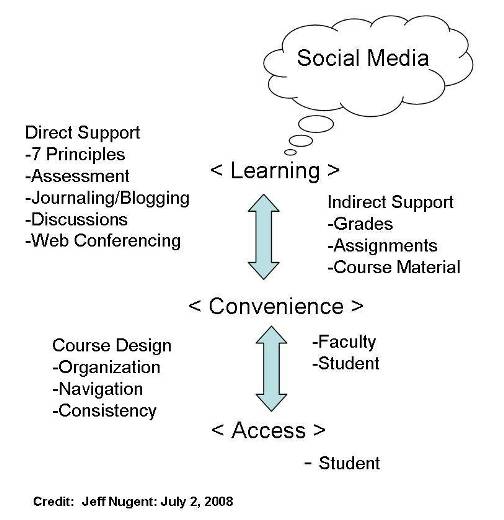Jeff Nugent, Bud Deihl and I were brainstorming about workshops to offer next fall to the VCU faculty, and we began to take apart our normal offerings of the various “tools” associated with instructional technology. Jeff began to draw on the whiteboard (yes…we still go low tech at times….) and laid out the following visualization of how our institution uses our learning management system (Blackboard):
As validated by the ECAR study over the past four years, students by and large want faculty to use course management systems like Blackboard because of the access and convenience it gives them to course content, assignments, and grades. Faculty likewise appreciate the convenience that it gives them to post materials and communicate with students.
Our challenge is that while a majority of faculty “use” Blackboard, they are not necessarily using it for learning. As a course management system, the focus has been on management – posting material, collecting homework, posting grades. Many faculty are missing a wonderful opportunity to use a course management system as a tool that facilitates learning.
When we in faculty development focus on tools such as Blackboard, we run the risk of reinforcing this faculty and student desire to develop a portal for access and convenience. Focusing on the set-up of Blackboard tends to focus one on design features (course layout, organization, navigation, etc) and on the indirect support features to learning, such as gradebooks, assignments, and loading of course material.
Our focus recently has been more to see Blackboard as a place in which to jump off into social media. As Mike Wesch noted in a recent presentation, students are interested in learning but not necessarily interested in school or classes. One way to change that perception is to give the students their voice and give them responsibility for their own learning. Web 2.0 provides some rich environments for this to occur and the use of Web 2.0 apps links nicely with Chickering and Gamson’s Seven Principles for Good Practice in Undergraduate Education. We have been exploring the use of social bookmarking within classes, blogging, and collaborative writing through Google Docs and wikis. There is no reason NOT to use the access and convenience afforded by the course management system, but one should not stop there.
I would be interested in comments from others on what you are doing to move both faculty and students beyond access and convenience to uses that support active learning.

I think the challenge is in combining the grading and communication tools of BB with the active learning component. For example, my classes use of Google docs really makes BB superfluous. I can write comments and grades on their docs and cut down my grading time by half. (In BB, I have to open the doc, grade, save and return e-mail.)
It is easier to enter the grades in the gradebook manually than to place google doc posts in the BB system.
Thanks for sharing your thoughts & brainstorm Britt. Your post strikes a chord with me and my thinking about how to develop appropriate professional development that goes beyond the ‘tools’. It is fun to do the show and tell about the tools available, but we need to be giving more… I think the challenge is to provide authentic examples of the use of the tools for both staff and students. We’ve just implemented a project where we have a powerlink in Blackboard that can set up a drupal/SMF or mediawiki for a class. I’m thinking about how to introduce this to staff so that they can ‘get it’ quickly. Training in the tool is important, but what and why is key. My initial thoughts on how to do this include; homework before session, purposeful activities, bring along your own content, group work and introduction/membership to a forum for continued support…
It also means we may need to take risks and be brave when setting up learning opportunities for students. Maybe be more creative with assessment as well? Like, involve the students in deciding what the assessment could be (if the systems and policy allow this).
@Cindy – great comment. I am a big believer in manual grades for work done outside Blackboard as well.
and @Colin – great point about setting up the training for a quick return on investment by faculty. And I think the same would be true for students. Giving students a voice and quick payoffs can lead to deeper searching and exploration as follow-ups.
Hi Britt!
At our faculty I took the decision to use web 2.0 tools in almost everything. So I started with wikispaces as a course management tool (and it works just fine), and now I am using currently social bookmarking, google apps, slideshare, flickr etc. As CMS I discovered that NING is great and now after we finished a course about microblogging on a mb platform I decided to include this tool , too (in october).
I ran a survey in the last two years to see if this is actually working and I found out that my students (not all of them – 🙁 ) are really exciting about the new opportunities for LEARNING, social learning mainly in 2.0 time.
Thanks for sharing this post.